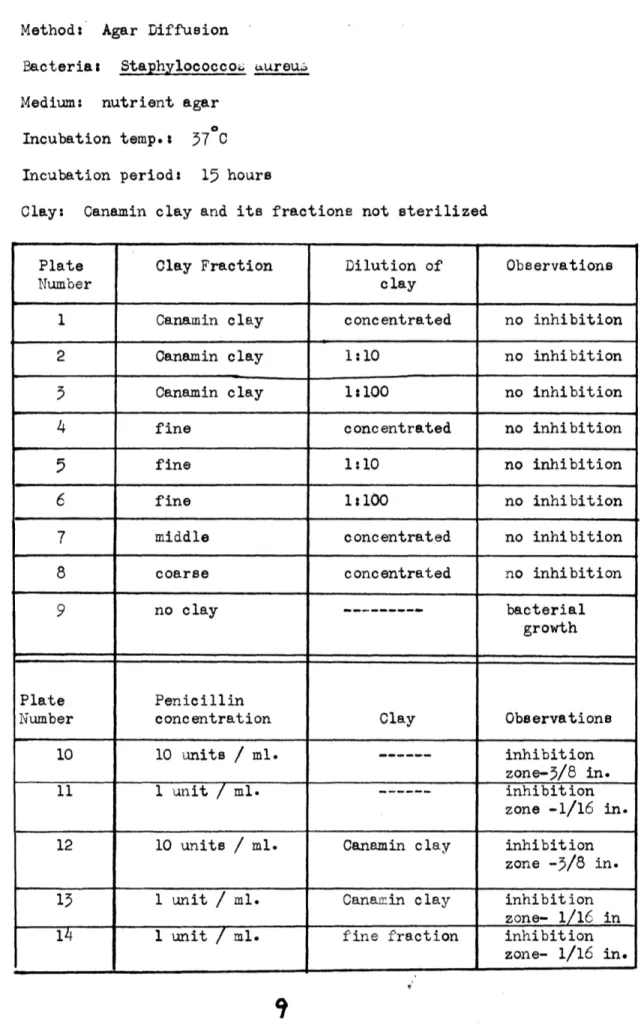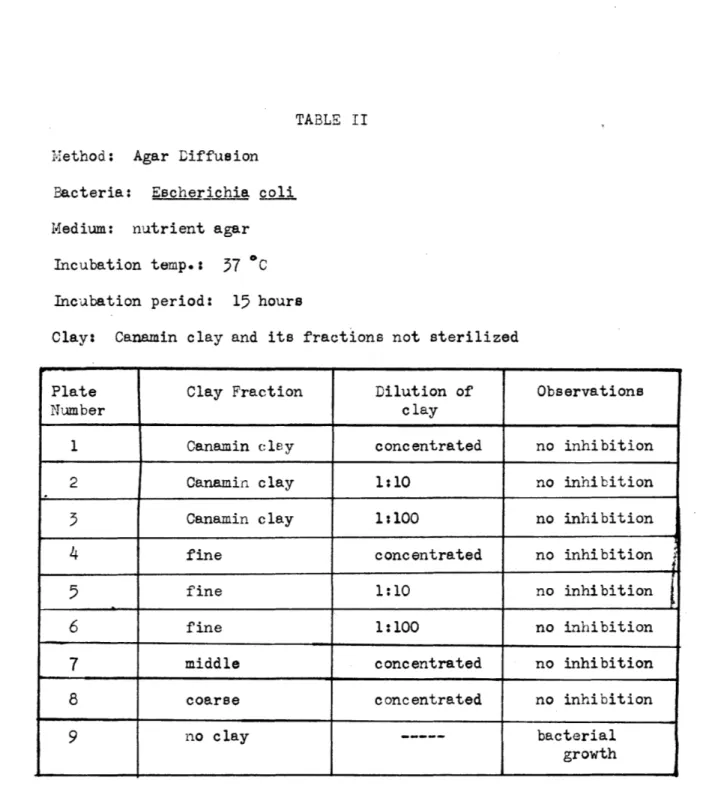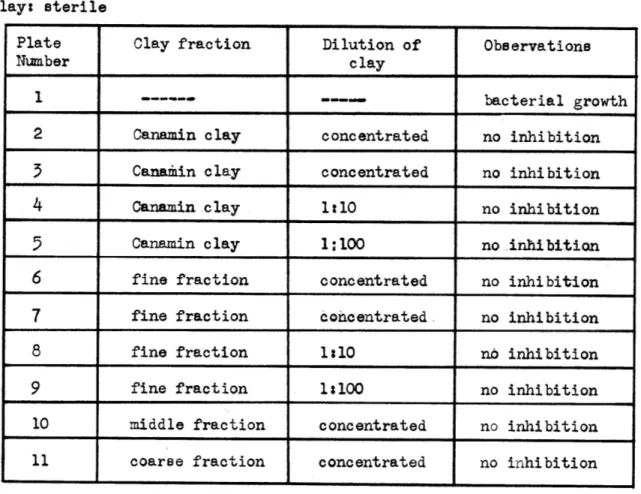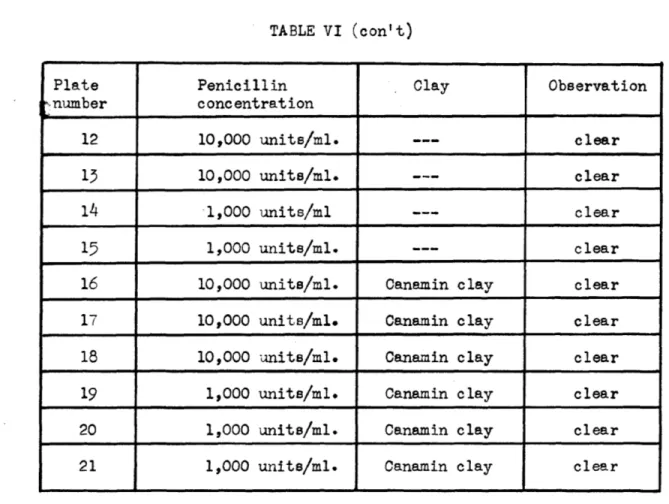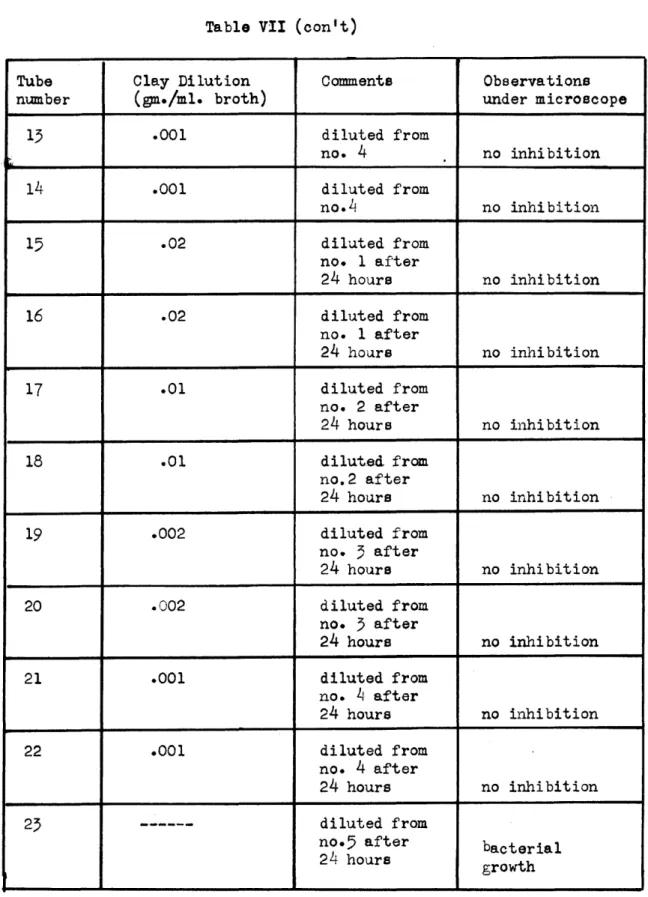,THE ANT IBIOTIC BEHAVIOR
OF
CANAMIN CLAY
by
Priscilla Maurer
Suhmitted in Partial Fulfillment of the Requirements for the
Degree of Bachelor of Science at the
Massachusetts Institute of Technology 1951
Signature of Faculty Advisior
Signature of Head of Department
Signature of the Author _
Massachusetts Institute of Technology Department of Chemical Engineering Cambridge, Mass.
May 18, 1951
Professor Joseph S. Newell Secretary of the Faculty
Massachusetts Institute of Technology Cambridge, Massachusetts
Dear Sir:
In partial fulfillment of the requirements for the degree of Bachelor of Science, I subnit herewith my thesis, entitled "The Antibiotic Behavior of Canamin Clay".
ACKNOWLEDGMENTS
The author wishes to express her deepest appreciation and sincere gratitude:
To Dr. Ernst A. Hauser for his wise counsel and enthusiastic encouragement in supervising this thesis.
To Dr. Cecil Dunn for his kind cooperation and guidance in all the bacteriological work in this thesis.
To the Food Technology Department for the bacteria and sterile equipment that they so generously gave.
SUMMARY
The purpose of this work was to ascertain the cause and the degree of the inhibition of bacterial growth exhibited by Canamin clay. Screening tests for antibiotics and adsorbtion tests with bacteria were conducted under varying conditions. The Agar Diffusion., Agar Plate Dilution and the Serial Dilution procedures were modified slightly for use with the clay and four of its fractions.
No inhibition of bacterial growth could be observed in these tests. It is recommended that an investigation of the clay
be continued with specific reference to its properties as a protective coating for the infected area.
TABLE OF CONTENTS Contents page Summary ii Introduction Procedure
5
Results 7Conclusions and Recommendations 8
Appendix 9
Bibliography 19
INTRODUCTION
The discovery of Canamin clay and its subsequent use in the healing of epidermal and intestinal infections resulted in basic research in order to determine the cause of this healing ability. Work had been done up to December 1950 on the physical and chemical nature of the clay. It had been discovered that the clay was an aluminum silicate of varying particle size and that the percent of elements present varied with the particle size. The
smallest particle size could not be photographed clearly under the electron-microscope.(1).
The very high ratio of surface area to volume in the clay led to the hypothesis that the clay owed its healing properties to the adsorbtion of bacteria and the inhibition of the bacteria growth because of it. The
bacteria were observed to be adsorbed by the clay under the ultramicroscope.(1).
The problem remained as to whether the adsorbtion of the bacteria affected their growth, and if so, which fractions of the clay were most effective in adsorbing the bacteria. The purpose of this thesis was to investigate the above problems, and also to determine the effectiveness of the clay when used with Penicillin.
It was decided to use the general tests for antibiotics, and to adapt these methods to the study of adsorbtion on various fractions of the clay. Consideration of the list of important variables:
1. the method of bringing the bacteria into contact with the clay,
2. the physical and chemical nature of the medium, 5. the type of bacteria, and
4.
the type of control led to the conclusion that more than one experimental method should be used.The standard assay method for antibiotics was the first scheme selected.(4). However, the bacteria and the clay are separated by porcelain cylinders. Due to the unknomn effect of the cylinders this scheme was abandoned.
Three of the screening tests were selected from Waksman's techniques. (4,6). They had different ways of bringing the bacteria into contact with the clay. In the Agar Diffusion method the bacteria and clay were not in contact. This was done to eliminate the possibility of
other causes for the behavior of the clay. In the Agar Plate Dilution method the contact was made in the presence of agar, and in the Serial Dilution method the contact was made in the
presence of nutrient broth.
PROCEDURE
A. Preparation of Solutions
The Canamin clay was centrifuged to obtain the three fractions used. A one percent solution of the clay in distilled water was passed through the supercentrifuge until about three liters of overflow had been collected. The top one-quarter of the celluloid was selected as the fine fraction. The middle fraction was selected as a strip about one half inch in width at the center portion where no obvious discon-tinuity in particle size occured. The coarse fraction was removed from the lower hailf inchof the cellulose strip.
This procedure was repeated until fifteen grams of the fine fraction were collected. The middle and coarse fractions were both available in larger quantities.
In the Agar Diffusion and the Agar Plate-Dilution methods the sample of clay and each of the samples of clay fractions were dispersed in sterile distilled water by shaking them on the agar-agar shaker for five or six hours before preceding with the experiments.
In the Agar Plate-Dilution method the clay dispersions were sterilized in an autoclave for fifteen minutes at fifteen pounds pressure.
In the Serial Dilution method a one gram sample and a two gram sample of the superfine Canamin clay were sterilized in an autoclave for fifteen minutes at fifteen pounds pressure.
2. Bacteria
The test organisms of E. Coli, Bacillus s and Staph. aureus were incubated for 24 hours at 37 C.
5. Penicillin
Crystalline Penicillin G Sodium was dissolved with sterile distilled water to dilutions of 10,000, 1,000, 10, and 1, unite
/
ml. B. Waksman's Cylinder Plate MethodNutrient agar was added to the sterile Petri dishes to an approximate depth of
4mm.
To the still molten agar was added 3 ml. of a 1:10 dilution of the Staphylococcus reu. The Petri dish wasthen placed in the incubator at 57 C for 2 hours with the cover resting on three 3x5 mm porcelain cylinders. The purpose of this last step was to remove excess water. Five sterile porcelain
cylinders of the same dimensions were dropped from a height of 1/8 of an inch into the agar surface. The cylinders were equidistant from the center of the Petri dish.
The cylinders were filled in order with: 1. the 10 unit
/
ml. solution of penicillin.2. the concentrated suspension of one fraction of the clay. 3. the one unit
/
ml. solution of penicillin.4.
the 1:10 solution of the same fraction of clay.5. the 1:100 solution of the same fraction of clay. The Petri dishes were incubated at 370C for 24 hours, and then examined for zones of inhibition. This method was abandoned because of the unknown effect of the porcelain
cylinders on the clay.
-I
C. Agar Diffusion Method
Nutrient agar was added to sterile Petri dishes to a depth of 4 mm. The agar was seeded with one ml. of the test organism and then allowed to harden. A sterile cork borer, size 15, and a sterile spatula were used to remove the center of the agar. The space be-tween the bottom of the plate and the agar was sealed by pipetting one ml. of agar into the hole and allowing it to harden. One ml. of the test or control sample was pipetted into the hole.
The plates were incubated for fifteen hours at 37 C and examined for evidences of bacterial growth. The width of the clear ring of agar was measured.
D. Agar Plate-Dilution
One ml. of the test or control sample was added to the Petri dish. Nutrient agar was added, and carefully mixed with the sample. The agar was allowed to solidfy and streaked with the test organism. The plates were incubated for 24 hours at 37 C and
examined for bacterial growth. Slides were made from the growth taken from the Petri dishes containing the more concentrated samples. This was done to verify the visual observations. E. The Serial Dilution Method
A sterile one gram sample and a sterile two gram sample of superfine Canamin clay were added to different test tubes, each containing 9 ml. of nutrient broth. The test tubes were shaken for three hours on the agar-agar shaker. One ml. of each.of these dispersions was diluted with 9 ml. of nutrient broth.
One ml. of Staphylococcus Aureus was added to each of the four test tubes and they were again shaken for about a half hour. Two one ml. portions from each test tube were added to different test tubes containing 9 ml. of the nutrient broth. All test tubes were incubated for 24 hours at 37 C. Slides were made from each test tube.
After twenty-four hours of incubation, two one mjal. portions from each test tube were again added to separate test tubes containing 9 ml. of nutrient broth. These test tubes were incubated for 24 hours at 37 C. Slides were made from each test tube.
F. Controls
In each experiment a similar run was conducted using no clay. These blanks were only one form of control used. Penicillin
was used as a control with gram positive bacteria, ie., Staph. Aureus, and Bacillus s.
-RESULTS
RESULTS
In testing the Canamin clay for antibiotic behavior, no inhibition of the bacterial growth could be observed by the Agar Diffusion or the Agar Plate Dilution methods. No inhibition of the bacterial growth was
observed when the clay was tested for its adsorbtive properties by the Serial Dilution method. While the clay does adsorb some of the bacteria, the bacterial growth is not noticeably retarded by this adsorbtion.
The failure of the clay to show any inhibition of bacterial growth eliminated the possibilities of
discovering the relative effectiveness on bacterial growth of the various fractions, and their effectiveness when used jointly with Penicillin.
U ~ -~
CONCLUS IONS
AND
CONCLUSIONS AND RECOMMENDAT IONS
As a result of this work it is concluded that the adsorbtive properties of Canamin clay do not dause inhibition of bacterial growth, and that the Canamin clay does not possess any antibiotic behavior.
It is recommended that the healing of infections by Canamin clay be further investigated. The properties of the clay as a protective coating for the infections is postulated as one possible means by which the healing takes place.
Table I Method: Agar Diffusion
Bacteria: StaphylococcoiL aureu: Medium: nutrient agar
Incubation temp.: 57 C Incubation period: 15 hours
Clay: Canamin clay and its fractions not sterilized
Plate Clay Fraction Dilution of Observations
Number clay
1 Canamin clay concentrated no inhibition
2 Canamin clay 1:10 no inhibition
5 Canamin clay 1:100 no inhibition
4 fine concentrated no inhibition
5 fine 1:10 no inhibition
6 fine 1:100 no inhibition
7 middle concentrated no inhibition
8 coarse concentrated no inhibition
9 no clay --- bacterial
growth
Plate Penicillin
Number concentration Clay Observations
10 10 units
/
ml. --- inhibition11 1 unit
/
ml. --- inhibitionzone -1/16 in. 12 10 units
/
ml. Canamin clay inhibitionzone -3/8 in.
13 1 unit
/
ml. Canamin clay inhibitionzone-
1/16_in
14 1 unit
/
ml. fine fraction inhibitionzone- 1/16 in.
TABLE II Method; Agar Diffusion
Bacteria: Escherichia coli Medium: nutrient agar
Incubation temp.: 57 *C Incubation period: 15 hours
Clay: Canamin clay and its fractions not sterilized
Plate Clay Fraction Dilution of Observations
Number clay
1 Canamin cley concentrated no inhibition
2 Canamin clay 1:10 no inhibition
3 Canamin clay 1:100 no inhibition
4
fine concentrated no inhibition5
fine 1:10 no inhibition6 fine 1:100 no inhibition
7 middle concentrated no inhibition
8 coarse concentrated no inhibition
9 no clay --- bacterial
growth
/0
Table III Method: Agar Diffusion
Bacteria: Bacillus subtilis Medium: nutrient agar
Incubation temp.: 37*C Incubation period: 15 hours
Clay: Canamin clay and its fractions not sterilized
Plate Clay Fraction Dilution of Observations
number clay
1 Canamin clay concentrated no inhibition
2 Canamin clay 1:10 no inhibition
5 Canamin clay 1:100 no inhibition
4 fine concentrated no inhibition
5 fine 1:10 no inhibition
6 fine 1:100 no inhibition
7
middle concentrated no inhibition8 coarse concentrated no inhibition
9 no clay --- bacterial
growth
Plate Penicillin Clay Observations
number concentration
10 10 units/ ml. --- inhibition
zone-3/8 in.
11 1 unit
/
ml. --- inhibitionzone -1/16 in.
12 10 units
/
ml. Canamin clay inhibitionzone - /8 in.
13 1 unit
/
ml. Canamin clay inhibitionzone-
1/16
in. 14 1 unit/
ml. fine fraction inhibitionzone - 1/16 in.
TABLE IV Method: Agar Plate- Dilution
Bacteria:.:Staphylococcus aureus Medium: nutrient agar
Incubation temp.: 7' C Incubation period: 24 hours Clay: sterile
Plate Clay fraction Dilution of Observations
Number clay
1 --- bacterial growth
2 Canamin. clay concentrated no inhibition
3
Canamin clay concentrated no inhibition4 Canamin clay 1:10 no inhibition
5
Canamin clay 1:100 no inhibition6 fine fraction concentrated no inhibition
7 fine fraction concentrated no inhibition
8 fine fraction 1:10 no inhibition
9 fine fraction 1:100 no inhibition
10 middle fraction concentrated no inhibition 11 coarse fraction concentrated no inhibition
TABLE IV (con't)
Plate Penicillin Clay Observations
Number Concentration
12 10,000 units /ml. clear
13 10,000 units/mi. --- clear
14
1,000 units/ml. --- clear15 1,000 units
/
ml. --- clear16 10,000 units /ml. Canamin clay clear
17 10,000 units/mi. Canamin clay clear
18 10,000 units /ml. Canamin clay clear
19 1,000 units /ml. Canamin clay clear
20 1,000 units /ml. Canamin clay clear
.21 1,000 units /ml. Canamin clay clear
'3
TABLE V Method: Agar Plate- Dilution
Bacteria: Escherichia coli Medium : nutrient agar Incubation temp.: 376C Incubation period: 24 hours
/4
Plate Clay Fraction Dilution of Observations
Number clay
1 --- bacterial growth
2 Canamin clay concentrated no inhibition 3 Canamin clay concentrated no inhibition
4 Canamin clay 1:10 no inhibition
5 Canamin clay 1:100 no inhibition
6 fine fraction concentrated no inhibition
7 fine fraction concentrated no inhibition
8 fine fraction 1:10 no inhibition
9 fine fraction 1:100 no inhibition
10 middle fraction concentrated no inhibition 11 coarse fraction coreentrated no inhibition
TABLE VI Method: Agar Plate-Dilution
Bacteria: Bacillus subtilis Medium: nutrient agar
Incubation temp.: 7*0C Incubation period: 24 hours Clay: sterile
Plate Clay fraction Dilution of Observations
Number clay
1 bacterial growth
2 Canamin clay concentrated no inhibition
3
Canamin clay concentrated no inhibition4 Canamin clay 1:10 no inhibition
5 Canamin clay 1:100 no inhibition
6 fine fraction concentrated no inhibition 7 fine fraction concentrated, no inhibition
8 fine fraction 1:10 n6 inhibition
9 fine fraction 1:100 no inhibition
10 middle fraction concentrated no inhibition 11 coarse fraction concentrated no inhibition
/3-
Ti-TABLE VI (con't)
Plate Penicillin Clay Observation
-number concentration
12 10,000 units/mi. clear
13 10,000 units/mi. --- _clear
14 1,000 units/ml clear
15 1,000 units/ml. clear
16 10,000 units/ml. Canamin clay clear
17 10,000 units/mi. Canamin clay clear 18 10,000 units/ml. Canamin clay clear
19 1,000 units/mi. Canamin clay clear
20 1,000 units/ml. Canamin clay clear
TABLE VII Method: Serial Dilution
Bacteria: Staphylococcus aureus Medium: Nutrient broth
Incubation period: 24 hours Incubation temp: 57'0
Clay: sterilized superfine Canamin clay
Tube Clay Dilution Comments Observations
number (gm. /ml/ broth) under microscope
1 .2 original large bacteria
dispersion agglomerates
2 .1 original large bacteria
dispersion agglomerates
5
.018 diluted from bacteriano. 1 agglomerates
4 .009 diluted from bacteria
no. 2 agglomerates
5
control bacterial growth 6 .02 diluted from no. 1 no inhibition 7 .02 diluted from no.1 no inhibition 8 .01 diluted from no. 2 no inhibition 9 .01 diluted from no.2 no inhibition 10 .002 diluted from no.5 no inhibition 11 .002 diluted from no-5 no inhibition12 --- diluted from bacterial
no
5
growth17
Table VII (con't)
Tube Clay Dilution Comments Observations
number (gm./ml. broth) under microscope
13 .001 diluted from no. 4 no inhibition 14 .001 diluted from no.4 no inhibition 15 .02 diluted from no. 1 after 24 hours no inhibition 16 .02 diluted from no. 1 after 24 hours no inhibition 17 .01 diluted from no. 2 after 24 hours no inhibition 18 .01 diluted from no.2 after 24 hours no inhibition 19 .002 diluted from no.
5
after 24 hours no inhibition 20 .002 diluted from no. 3 after 24 hours no inhibition 21 .001 diluted from no. L, after 24 hours no inhibition 22 .001 diluted from no. 4 after 24 hours no inhibition 23 --- diluted fromno.5 after bacterial
24 hours growth
TW
BIBLIOGRAPHY
(1) Hauser, E.A., Canamin Clay and its Properties, Canadian Chemistry and Process Industries, December, 1950.
(2)
(5)
I
Colloidal Phenomena, McGraw-Hill, New York,1959.
Colloidal Chemistry of Clays, Chem. Revs.,
51,
287 (1945).
(4) Prescott, S.C., and Dunn, C. G., Industrial Microbiology, McGraw-Hill, New York, 1959.
(5)
Vancouver Medical Association, Curative Properties of Rare Earths Found in B.C. Peloid Deposits, The Bulletin, July, 1946.(6) Waksman, S. A., Microbial Antagonisms and Antibiotic Substances, the Commonwealth Fund, New York, 1945
